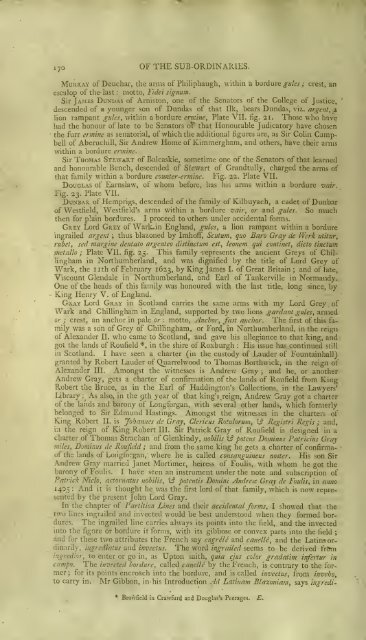A System of Heraldry - Clan Strachan Society
A System of Heraldry - Clan Strachan Society
A System of Heraldry - Clan Strachan Society
You also want an ePaper? Increase the reach of your titles
YUMPU automatically turns print PDFs into web optimized ePapers that Google loves.
i 7 o<br />
OF THE SUB-ORDINARIES.<br />
MURRAY <strong>of</strong> Deuchar, the arms <strong>of</strong> Philiphaugh, within a bordure g ules ; crest, an<br />
esculop <strong>of</strong> the last : motto, Fidei signum.<br />
Sir JAMES DUNDAS <strong>of</strong> Arniston, one <strong>of</strong> the Senators <strong>of</strong> the College <strong>of</strong> Justice,<br />
descended <strong>of</strong> a younger son <strong>of</strong> Dundas <strong>of</strong> that Ilk, bears Dundas, viz. argent, a<br />
lion rampant gules, within a bordure ermine, Plate VII. fig. 21. Those who have<br />
had the honour <strong>of</strong> late to be Senators o? that Honourable Judicatory have chosen<br />
the furr ermine as senatorial, <strong>of</strong> which the additional figures are, as Sir Colin Campbell<br />
<strong>of</strong> Aberuchill, Sir Andrew Home <strong>of</strong> Kimmergham, and others, have their arms<br />
within a bordure ermine.<br />
Sir THOMAS STEWART <strong>of</strong> Bulcaskie, sometime one <strong>of</strong> the Senators <strong>of</strong> that learned<br />
and honourable Bench, descended <strong>of</strong> Stewart <strong>of</strong> Grandtully, charged the arms <strong>of</strong><br />
that family within a bordure counter-ermine. Fig. 22. Plate VII.<br />
DOUGLAS <strong>of</strong> Earnslaw, <strong>of</strong> whom before, has his arms within a bordure vair.<br />
Fig. 23. Plate VII.<br />
DUNBAR <strong>of</strong> Heuiprigs, descended <strong>of</strong> the family <strong>of</strong> Kilbuyach, a cadet <strong>of</strong> Dunbar<br />
<strong>of</strong> Westfield, Westfield's arms within a bordure vair, or and gules. So much<br />
then for plain bordures. I proceed to others under accidental forms.<br />
GREY Lord GREY <strong>of</strong> Wark. in England, gules, a lion rampant within a bordure<br />
ingrailed argent ; thus blazoned by Imh<strong>of</strong>f, Scutum, quo Baro Gray de Werk utitur,<br />
rubst, sed margine dentato argenteo distinctum est, leonem qui continet, dicto tinctum<br />
metallo ; Plate VII. fig. 25. This family -represents the ancient Greys <strong>of</strong> Chillingham<br />
in Northumberland, and was dignified by the title <strong>of</strong> Lord Grey <strong>of</strong><br />
Wark, the nth <strong>of</strong> February 1623, by King James I. <strong>of</strong> Great Britain ; and <strong>of</strong> late,<br />
Viscount Glendale in Northumberland, and Earl <strong>of</strong> Tankerville in Normandy.<br />
One <strong>of</strong> the heads <strong>of</strong> this family was honoured with the last title, long since, by<br />
King Henry V. <strong>of</strong> England.<br />
GRAY Lord GRAY in Scotland carries the same arms with my Lord Grey <strong>of</strong><br />
Wark and Chillingham in England, supported by two lions gardant gules, armed<br />
anchor. The first <strong>of</strong> this fa-<br />
or ; crest, an anchor in pale or : motto, Anchor, fast<br />
mily was a son <strong>of</strong> Grey <strong>of</strong> Chillingham, or Ford, in Northumberland, in the reign<br />
<strong>of</strong> Alexander II. who came to Scotland, and gave his allegiance to that king, and<br />
got the lands <strong>of</strong> Roufield *, in the shire <strong>of</strong> Roxburgh<br />
: His issue has continued still<br />
in Scotland. I have seen a charter (in the custody <strong>of</strong> Lauder <strong>of</strong> Fountainhall)<br />
granted by Robert Lauder <strong>of</strong> Quarrelwood to Thomas Borthwick, in the reign <strong>of</strong><br />
Alexander III. Amongst the witnesses is Andrew Gray ; and he, or another<br />
Andrew Gray, gets a charter <strong>of</strong> confirmation <strong>of</strong> the lands <strong>of</strong> Roufield from King<br />
R.obert the Bruce, as in the Earl <strong>of</strong> Haddington's Collections, in the Lawyers'<br />
Library : As also, in the pth year <strong>of</strong> that king's , reign, Andrew Gray got a charter<br />
<strong>of</strong> the lands and barony <strong>of</strong> Longforgan, with several other lands, which formerly<br />
belonged to Sir Edmund Hastings. Amongst<br />
the witnesses in the charters <strong>of</strong><br />
King Robert II. is Johannes de Gray, Clericus Rotulorum, & Registri Regis ; and,<br />
i:i the reign <strong>of</strong> King Robert III. Sir Patrick Gray <strong>of</strong> Roufield is designed in a<br />
charter <strong>of</strong> Thomas <strong>Strachan</strong> <strong>of</strong> Glenkindy, nobilis & patens Dominus Patricius Gray<br />
miles, Dominus de Roufield ; and from the same king he gets a charter <strong>of</strong> confirma<strong>of</strong><br />
the lands <strong>of</strong> Longforgan, where he is called cons anguine us noster. His son Sir<br />
Andrew Gray married Janet Mortimer, heiress <strong>of</strong> Foulis, with whom he got the<br />
barony <strong>of</strong> Foulis. I have seen an instrument under the note and subscription <strong>of</strong><br />
Patrick Nick, actornatus nobilis, iS potentis Domini Andrea Gray de Foulis, in anno<br />
1405: And it is thought he was the first lord <strong>of</strong> that family, which is now represented<br />
by the present John Lord Gray.<br />
In the chapter <strong>of</strong> Partition Lines and their accidental forms, I showed that the<br />
two lines ingrailed and invected would be best understood when they formed bordures.<br />
The ingrailed line carries always its points into the field, and the invected<br />
into the figure or bordure it forms, with its gibbose or convex parts into the field ;<br />
and for these two attributes the French say engrele and candle, and the Latins ordinarily,<br />
ingrediatus and invectus. The word ingrailed seems to be derived from<br />
ingrediar, to enter or go in, as Upton saith, quia ejus color gradatim infertur in<br />
to the for-<br />
campf). The invected bordure, called canelle by the French, is contrary<br />
mer ; for its points encroach into the bordure, and is called invectus, from inveho,<br />
to carry in. Mr Gibbon, in^his Introduction 4d Latinam Blazoniam, says ingredj.-<br />
* Browfield in Crawfurd and Douglas's Peerages. E*




